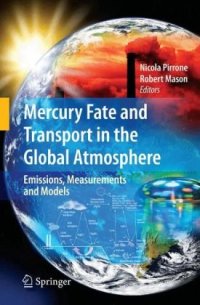
Ebook: Mercury Fate and Transport in the Global Atmosphere: Emissions, Measurements and Models
- Genre: Physical Education and Sport
- Tags: Environmental Law/Policy/Ecojustice, Ecotoxicology, Atmospheric Protection/Air Quality Control/Air Pollution
- Year: 2009
- Publisher: Springer US
- Edition: 1
- Language: English
- pdf
Mercury Fate and Transport in the Global Atmosphere highlights major issues related to the interactions of mercury with terrestrial and aquatic ecosystems, and evaluates the relative contribution of anthropogenic and natural sources to the global atmospheric mercury budget. This book provides a state-of-the-art overview on different aspects related to mercury emissions from natural and anthropogenic sources, the evaluation of mercury concentrations and fluxes in different regions of the world, and global atmospheric mercury models currently used to assess spatial distributions of mercury compounds in ambient air and source-receptor relationships. The preparation of this book has been made possible thanks to the contributions of all members of the United Nations Environment Programme Global Partnership for Mercury Air Transport and Fate Research (UNEP-MFTP), and of more than 70 scientists from leading universities and research institutions recognized as worldwide experts on different aspects related to emissions, monitoring and modeling mercury in the atmosphere and other environmental compartments. Mercury Fate and Transport in the Global Atmosphere is intended to provide a scientific support to nations and the UNEP Governing Council that have been asked to shape the most efficient and economic concerted actions to reduce the impact of mercury contamination on human health and the environment.
Mercury, primarily because of its existence and bioaccumulation as methylmercury in aquatic organisms, is a concern for the health of higher trophic level organisms, or to their consumers. This is the major factor driving current research in mercury globally and in environmental regulation, and is the driver for the current UNEP Global Partnership for Mercury Transport and Fate Research (UNEP F&T) initiative. The overall focus of the UNEP F&T report is to assess the relative importance of different processes/mechanisms affecting the transfer of mercury (Hg) from emission sources to aquatic and terrestrial receptors and provide possible source-receptor relationships. This transfer occurs through atmospheric transport, chemical transformations and subsequent deposition, and involves the intermittent recycling between reservoirs that occurs prior to ultimate removal of Hg from the atmosphere. Understanding the sources, the global Hg transport and fate, and the impact of human activity on the biosphere, requires improved knowledge of Hg movement and transformation in the atmosphere. An improved understanding of Hg emission sources, fate and transport is important if there is to be a focused and concerted effort to set priorities and goals for Hg emission management and reduction at the national, regional and global levels; and to develop and implement such policies and strategies. To achieve this, a series of coordinated scientific endeavors focused on the estimation of sources, measurement and validation of concentrations and processes, and modeling, coupled with interpretation of the results within a policy framework, is likely to be required.